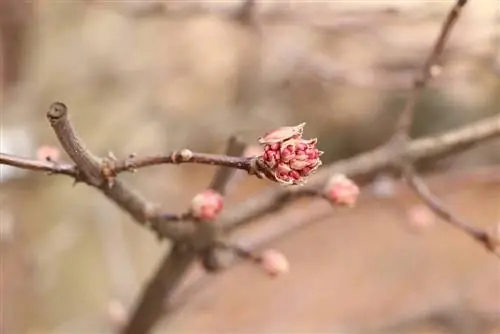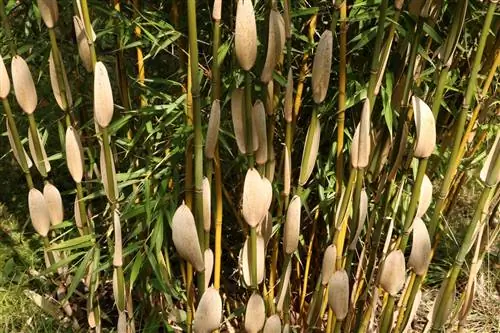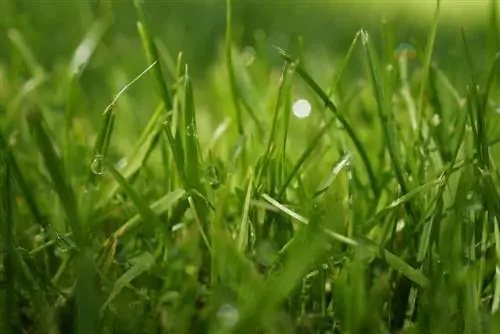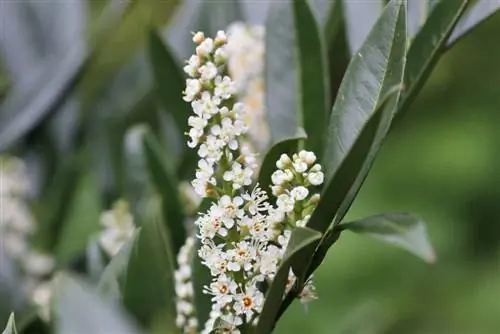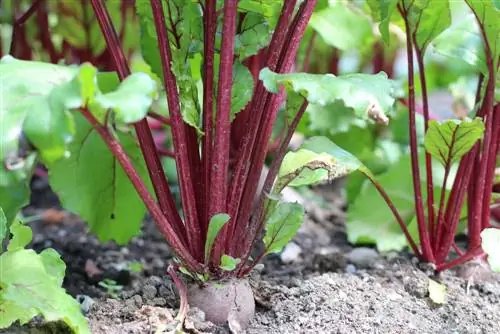- Author admin [email protected].
- Public 2023-12-17 03:39.
- Last modified 2025-01-24 12:45.
The winter viburnum, also known as Bodnant viburnum (Viburnum bodnantense), is a so-called winter bloomer. This fragrant ornamental shrub belongs to the musk herb family (Adoxaceae). The hybrid is the result of a cross between the winter viburnum (Viburnum farreri) and the large-flowered viburnum (Viburnum grandiflorum), around 1935 in Bodnant (North Wales). Viburnum bodnantense 'Dawn', a clone, is the most popular variety with its full pink flower balls that smell of vanilla. Planted as a solitary shrub or in groups, it looks particularly good in prominent places, such as front gardens.
Location
Dense, deep green foliage in summer, dark red foliage in autumn, beginning to bloom in winter, the Bodnant viburnum offers a magical sight in every season. Not just in spring.
This means for the selection of the location:
Everyone should see it! And smell of course!
Its captivating vanilla-like scent not only delights insects. So a spot near the terrace or in front of a window would be ideal.
The pretty winter bloomer also feels at home in the city, in a small green space or in the front garden. Of course, not only aesthetic criteria should play a role in the selection of the location. The winter snowball likes it warm and sunny. It likes to stand in a south-facing position, somewhat sheltered from the wind, near a wall or an evergreen hedge.
The expected dimensions are also important for the right location:
- Growth height 2.50 m to 3.0 m
- Growth rate annually +/- 20 cm
- Width 2 to 3 m
- Shallow roots, location distance 1, 50 m to 2 m
Tip:
Due to the risk of waterlogging, you should avoid depressions as a location.
Floor
When it comes to soil, the Bodnant viburnum 'Dawn' is not particularly demanding. It is very adaptable when it comes to pH values and tolerates a value from acidic to slightly alkaline (pH value 5.5 -8). However, it cannot tolerate permanently moist soil or even waterlogging. The ground may be a little dry. The properties for the perfect soil are: nutrient-rich and permeable.
Pouring
When watering, it is important to avoid extremes. The winter snowball must not dry out and it does not like to sit in water either. He should not receive additional water automatically and regularly, but rather depending on the weather and needs.
A good indicator for watering is the top layer of soil. If it feels dry, he is grateful for water. He is not at all picky when it comes to water quality. It tolerates the tap water from the hose. Don’t forget to water even in winter and early spring. During this time it forms its flowers and must not dry out.
Fertilize
Good news again: the Bodnant viburnum does not need any additional fertilizer. He gets what he needs from the garden soil. If you are particularly kind to him, you can occasionally give him some green waste, bark mulch or compost. If the Bodnant viburnum is on very poor soil, you can give it a complete organic fertilizer in early spring.
Cutting
The Bodnant viburnum grows rather slowly, regular cutting is not necessary. From time to time you can give it a bit of shape. A radical pruning is not necessary. If it is cut almost to the vine, you have to expect that you won't be able to admire any flowers the following year.
Late spring, after flowering, is best suited for cutting. Sick, dead branches can be removed or branches that disrupt the overall appearance. Remove older branches as far down as possible. It is better to spare the new shoots for the flowers in the following year.
Wintering
Basically, the winter viburnum is hardy. Although late, hard frosts in early spring can have a negative impact on the flowers. However, it does not need any special protection for the winter, unless it has landed in a really cold region of Germany. If very heavy frost is expected, a layer of mulch sprinkled over the surface roots can provide some protection.
Plants
Viburnum bodnantense 'Dawn' is sold in containers almost everywhere in garden centers. It can be planted from spring to late autumn. It is best to use it as soon as possible after purchasing.
The planting hole should be dug almost twice as large as the root ball is. Be sure to pay attention to your neighborhood and keep a distance of 1.50 to 2 meters from the next plant. Because the winter viburnum has shallow roots, it develops many runners in width and directly beneath the surface.
Then place the plant so high in the planting hole that the upper side of the root ball still has to be barely covered with soil. When filling with soil, press it down carefully and ensure that no air holes remain between the roots. If you like, you can give the bush some well-ripened compost. Finally, pour thoroughly. The next watering, even after new planting, should only be given when the soil surface is completely dry.
When planting in rows or hedges, a distance of 60 cm between the individual plants is sufficient. If the gaps bother you in the first few years, you can initially put so-called filler bushes between them. These can be, for example, shrubs such as chokeberries, spar bushes, privet or crabgrass. If the soil has enough density and size, it can be removed again.
Tip:
Before purchasing a winter snowball, you should consider that all parts of the plant (fruits, bark and leaves) are slightly poisonous. So be careful with small children and pets in the household! Consumption leads to nausea and vomiting. When working on the bush you should wear gloves to avoid skin irritation.
Neighborhood
As neighbors or as underplanting, horned violets, forget-me-nots and crocuses look magical. If the snowball is planted in a mixed hedge, dogwood, hydrangea or ornamental cherry are attractive companions to enjoy a varied play of colors at any time of year.
Bucket Culture
The Viburnum bodnantense 'Dawn' is not exactly a container plant. Cultivating it in planters definitely requires more care than putting it outdoors. The pot shouldn't be too big right from the start, as the motto is that it can then grow into it. It is better to let the bucket slowly grow together with the winter snowball. This means that every two years it should be repotted into a slightly larger container with new substrate. In general, wide pot varieties are to be preferred, as the winter viburnum is a shallow-rooted plant.
Setting up the planter with a properly functioning drainage layer and high-quality substrate as well as care requires a lot of care:
- coarse gravel on the bottom of the bucket
- Fleece as a separating layer
- pH value substrate 5.5 to 6.0
- high-quality soil, compost, lava granules
- Fertilization: complete nutrient 4 g per liter of substrate every year
- water regularly, do not let it dry out
- water from time to time even in winter
- Overwintering in a frost-free room
- Winter outside only with sufficient protection
Propagation
The winter viburnum is pollinated by insects when it blooms. The result is quite inconspicuous, dark blue, frosted stone fruits. But propagation by seeds is not very promising. Propagation works better with cuttings, cuttings, root runners or sinkers.
Cuttings
The cuttings are best cut and planted in May. Then the ground is nice and warm and the first roots can develop more easily. Cuttings are obtained from shoot tips. These are cut to a length of approx. 15 to 20 cm and the leaves and flowers are removed. Then they are buried up to a third deep in the soil or in small cultivation pots. The environment should now be as warm and bright as possible. As soon as the first roots have formed, the young plant can be planted at its destination.
Cuttings
Cuttings are annual, mature, slightly woody and leafless shoots. Here it is advisable to cut several cuttings in the fall and put them in a nutrient-rich, not too sunny corner of the garden, because not everyone will do it. Cut the cuttings to approx. 20 cm and remove all leaves. There should be an eye at the top and bottom.
Tip:
Some gardeners overwinter the cut sticks in a bag in the refrigerator and then plant the sticks in spring.
Root runners
Root suckers emerge from time to time directly from the soil around the shrub. You just need to separate them in the spring and you can immediately put them back in a partially shaded location. Always keep it moist for the first time.
Lowers
When the Viburnum bodnantense is a little older, the branches bend in an arc towards the ground. If a shoot is long enough, it can be fixed in the ground with a hook. Keep this area well moistened. As soon as roots have formed, separate the shoot from the mother plant and reinsert it in the desired location.
Varieties

In addition to the Viburnum bodnantense 'Dawn' variety, there are two other varieties of the Bodnant winter snowball that are available in garden centers here. The Viburnum poulus varieties and the scented viburnum are also well known, although not as early flowering as the winter viburnum bushes:
Winter snowball 'Charles lamont' (Viburnum bodnantense 'Deben')
- Flower color: dark pink buds at the beginning of flowering, then pink flowers
- Flowering period: winter to spring (March/April)
Winter snowball Deben (Viburnum bodnantense 'Deben')
- Flower color: white
- Flowering period: winter to spring (March/April)
Korean scented snowball (Viburnum carlesii)
- Flower color: pink buds, white flowers
- Flowering time: Spring to May/June
Common viburnum (Viburnum opulus)
- Flower color: cream white
- Flowering period: late spring to June
Stuffed viburnum 'Roseum' (Viburnum opulus 'Roseum')
- Flower color: white to pale pink
- Flowering period: late spring to June
Diseases & Pests
There is also good news in the chapter on diseases and pests: If the Bodnant viburnum is not too moist and not too dry, an aphid infestation will only bother you from time to time. Gray mold occurs from time to time in persistently damp weather. Warmth and high humidity promote whitefly infestation.
Aphids
Aphids attack the young shoot tips. If you don't remove them early enough, entire branches become crippled. With a weekly shower of horsetail or nettle broth in spring, you can strengthen the plant and almost completely prevent infestation. Otherwise, the affected plant parts must be removed as quickly as possible. A natural predator of the Aphidoidea is the ladybird.
Whitefly
Particularly in humid, warm summer periods, regular inspection of the undersides of leaves is the best measure against whitefly infestation. You can then see sticky webs and white dots (the flies) on the undersides of the leaves. Destroy the affected parts immediately. Parasitic wasps are the natural predators of Trialeurodes vaporariorum. In cooler weather, whitefly reproduction stops.
Gray horse
Fungal diseases occur even more rarely in winter snowballs. If this does happen, the plant is usually weakened by an incorrect location or inadequate care. Here it helps to quickly and radically dispose of the affected plant parts. As a hobby gardener, you shouldn't immediately resort to fungicides and should rather ensure that the plants are treated with as little toxins as possible and with loving care.
Conclusion
Neighbors, walkers, bees, butterflies and bumblebees, they will all be happy about every Viburnum bodnantense 'Dawn' in their neighborhood. As an owner, you don't have a particularly difficult time with this robust and densely growing ornamental shrub. It steadfastly defies winter and many pests and diseases. It is undemanding to care for and often blooms when there is still snow on its branches. Depending on the weather, the flowering period extends into April.

